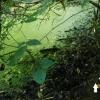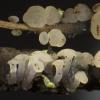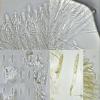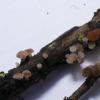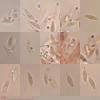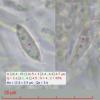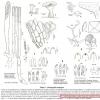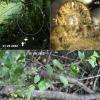
13-01-2026 18:55
Rees CronceStrossmayeria sp. on indet. decroticate hardwoodTh

13-01-2026 07:57
 Danny Newman
Danny Newman
cf. Bombardia on indet. decorticate woodAppalachia

11-01-2026 20:35
Hello.A very tiny pyrenomycete sprouting sparsely

13-01-2026 10:13
 Danny Newman
Danny Newman
Cordieritidaceae sp. on indet. wood w/ Hypoxylon s

13-01-2026 07:28
 Danny Newman
Danny Newman
Chlorociboria glauca on indet. decorticate logThe

13-01-2026 07:14
 Danny Newman
Danny Newman
Neodasyscypha cerina on indet decorticate logThe S

13-01-2026 09:10
 Danny Newman
Danny Newman
Dasyscyphella chrysotexta on indet. decorticate ha

13-01-2026 08:43
 Danny Newman
Danny Newman
Tricladium varicosporioides on indet. decorticate

13-01-2026 08:49
 Danny Newman
Danny Newman
Coccomyces sp. on fallen Rhododendron leavesPretty

12-01-2026 22:02
Ethan CrensonHello all, I am hoping someone will have some ins
Sur débris de branchettes, sous Carpinus betulinus, en bordure de mare forestière.
Apothécies cylindriques, stipitées, à hyménophore convexe, cespiteuses sur le substrat, blanches chez les jeunes puis grisonnant.
Taille du plus grand specimen = 3mm de diamètre pour 5mm de haut.
Asques bisériées [75 ; 90] x [7.5 ; 9.0]µm à apex de type Hymenoscyphus, IKI+ bb, crochet+.
Paraphyses pluriseptées, cylindriques sans épaississement au somment, avec une grande vacuole réfringente (uniquement dans le dernier secteur ?).
Ascospores en fuseau [14.5 ; 15.5] x [4.0 ; 4.5]µm soit Qmoy = 3.6 avec un contenu lipidique 4-5 (2 grosses gouttes principales toujours présentes et de nombreuses plus petites autour).
Pas vu de poils ni de cellules marginales particulières.
Excipulum ectal composé de cellules en textura prismatica orientées parallèlement à la surface de la fructification.
Sous-hyménium composé de cellules en boudins (moy. 30x10µm) en textura intricata non gelifiée.
Medulla composée d'hyphes grêles et allongés (entre 3 et 4µm de large) en textura intricata gelifiée.
Avec les éléments donnés, je pense que j'ai affaire à un Ombrophila (pouvez-vous confirmer?) ; ensuite dans ma doc je ne trouve aucune espèce qui possède des spores aussi grandes et avec de telles guttules.
Merci d'avance pour vos commentaires. Les images en meilleure qualité sont temporairement mises dans le lien ci-dessous :
https://www.grosfichiers.com/QB2XtCYctCu
31/07/2022 – Ozoir-la-Ferrière (77) – France – Study on fresh living material.
On decaying twigs, under Carpinus betulinus, next to a forest pond.
Cylindrical stipitate apothecia, gregarious on substrate, white at first then greyish. Hymenium constantly convex.
Biggest specimen is 3mm diameter and 5mm tall.
Asci 8-spored inoperculate, biseriate, [75 ; 90] x [7.5 ; 9.0]µm with Hymenoscyphus-type apex, IKI+ bb, croziers+.
Paraphyses cylindrical, pluriseptate, with remarkable vacuolar body filling the entire last septum.
Ascospores fusoid [14.5 ; 15.5] x [4.0 ; 4.5]µm - Qmoy = 3.6. Oil droplets level 4-5 (2 big drops are always there, numerous smaller ones around)
No hair, no striking marginal cells.
Ectal excipulum of textura prismatica oriented parallel to the surface of the fruitbody.
Subhymenium of textura intricata non gelatinized (big cells - moy. 30x10µm)
Medullary excipulum of textura intricata gelatinized (narrow and elongated cells - width 3 to 4µm)
Those elements are leading me to the genus Ombrophila (please confirm that ?) ; then I find no suitable species in my doc with spores that long and with such an oil content.
Thanks in advance for advices, pics with better graphics are temporarily accessible through the link below (for free !) :
https://www.grosfichiers.com/QB2XtCYctCu
Pierre-Yves

Content de te savoir assidu aux Helotiales !
Comme tu es un heureux bénéficiaire des services d'Ascomycete.org, tu as reçu récemment un superbe article de Zotto dan s notre revue, sur des espèces herbicoles d'Ombrophila.
Regardes si cette récolte ne correspondrait pas par hasard à celle évoquée sous le nom provoisoire de O. aff. ambigua ?
C'est une espèce que nous avons récoltée en Bretagne avec Brigitte et tu trouveras une bonne planche dans l'article .
Je viens récemment de la retrouver sur Lycopus europaeus dan sune zone marécageuse (sous Salix ) et je prépare un dosssier pour avancer sur ce taxon.
Ta récolte nous intéresse ..
Amitiés Michel


If the substrate (herb/wood) is actually differentiating, Pierre Yves 's find should not be aff. ambigua. as it is on small twigs.
I just had a look at your file rivulorum , with several collections which may include this find. It seems the work you initiated for the genus could well be continued -:)
Michel
I guess the substrate is woody; here is a photo of the section of the substrate witch is 6mm thick. I don't believe there was any Salix in the area but this is something I can check next time.
In addition to my description, I'd say that the fruit bodies are turning brown or brown-red when aging instead of greyish, see my pics from today, 3 days later.
Michel, I need some more time to read the article in its entirety but well the shape and content of your spores aff. ambigua photo 2f are actually close indeed.
Zotto, I quickly checked your HB3066, spores are close to mine as well, I need some more time to review your notes. In my doc, it is written for O. rivulorum : "Apothecia very pale flesh-rose, medulla not to faintly gelatinous", this is why I rejected this possibility.
Anyway I dried the specimen before they decay too much, I can send samples if needed.

Maybe I have a wrong definition of « gelifiée / gelatinized ». I stated «textura intricata gelifiée » because of the microscopic view ;
In pic "7" (what I consider the medulla is), cells are loose in the textura intricata and we can't distinguish other cells in different focal planes in the gaps => gélifié.
In pic "4" (what I consider the subhymenium is), cells are not loose in the textura intricata and we can distinguish other cells in different focal planes in the gaps => non gelifié.
The fruit body was not so much macroscopically gelatinous and I could radially cut it straight easily.
In presence of congo red, I found some spores that seem to be wrapped in a sheath ( ?) ; It is difficult for me to say if it is an artefact, a true sheath or just the remnant of ascus, I'd be interested in your opinion. I didn't see such a thing in all my preps in water.
Still in this overmature apothecia, most of the spores where already dead but I found some living ones, which were a bit smaller and with a lesser oil content than the aforementioned description.
I add here as well a pic of an ascus base for record.
Thank you Zotto for driving me in this study and sharing your documents for comparison.
I uploaded the new pics with good graphics in another link here : https://www.grosfichiers.com/QB2XtCYctCu

Zotto, I've got a related question after reading your article on Ombrophila ambigua (cf. attached photo) : could there be, in Helotiales, a correlation between maturity of spores and their amount of oil content ? Thanks for your time.

More over, end of August there were even more fruitbodies close to the spot, clearly connected to roots or decaying branches of Salix (photo#2).
